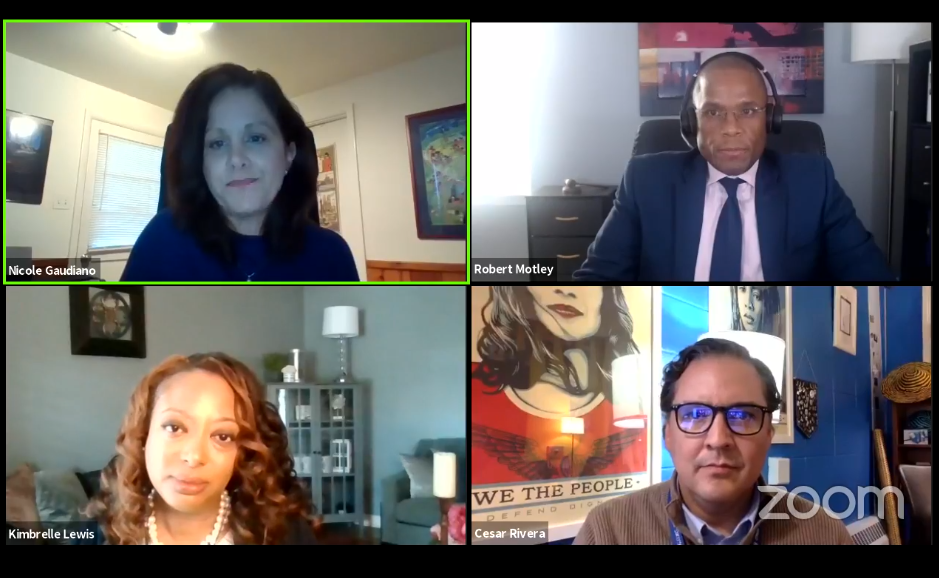How are school leaders navigating COVID-19?
As part of National Principals Month in October, representatives from AFSA, NAESP and NASSP discussed the challenges principals are facing during COVID-19 and explored schoolwide trends. You can watch the full program here.
Nicole Gaudiano, an education reporter for Politico, moderated the three panelists: Kimbrelle Barbosa Lewis, the NAESP president and principal of Cordova Elementary School in Cordova, Tennessee; Robert Motley, the NASSP president and principal of Atholton High School in Columbia, Maryland; and AFSA’s own Cesar Rivera, pPrincipal of Samuels Elementary School in Denver.
Lewis’ and Motley’s schools currently are operating virtually this semester, and Rivera’s is running a dual model with simultaneous five days a week in person and five days a week virtual.
The panel explored the issues that have arisen during the pandemic; Rivera noted that “leaders have had to solve for gaps [arising], and it has been an incredible challenge.”
“You have parents whose jobs keep them from being able to be with their children during learning time, so you have parents reaching out for places for their children to go during virtual learning,” Lewis said. “Our district has provided one-to-one devices, but you can only get a hotspot if you fall below a certain income level. Taking one step towards remedying a situation leaves 10 more situations to deal with.”
“We have taken for granted that children don’t have technology at home and indeed they do not,” Rivera said. “It’s unconscionable now that we’ve exposed that gap not to do something to close that gap.”
School leaders have been tasked with mitigating any issues that arise, but struggle with a lack of funding. Much of the discussion centered around the lack of adequate funding to support the smooth operation of schools.
“Ninety percent of the funds is helping the shift in getting technology in the hands of students for them to basically begin to receive their education,” Motley said. “This model is not working for our kids. How do we transition and work towards getting them to where they need to be successful? The funding that needs to come from our government is critical, more than just opening schools. Principals have to implement that process and make sure that it is safe.”
Lewis explained that teachers at her school have been able to do versions of home visits at the door to drop off supplies, provide spending cards for food, and offer Saturday academies to support vulnerable students and mitigate learning loss. However, the cycle of issues continues spinning when anticipating future learning loss and drops in enrollment exacerbating inequities in the system.
“Per pupil funding has to be reevaluated; schools need Congress now more than ever to put forward a package that can meaningfully support schools such that we can address gaps students have,” Rivera said.
The nature of assessments in relation to funding was heavily explored. “This is the prime time to reexamine how funding is tied to assessment[s],” Lewis said. “'If you don’t make the score, then you don’t get the money' is problematic, especially in a time when there is severe trauma and a severe lack of resources.”
“We are having teachers teach content areas they have never taught before," Rivera noted. "We are having teachers engage with children in ways they were not hired for. And yet we are still holding them to the same standard that we’ve ever held them to. We are so fixated on testing and all the strings attached as far as school funding that go along with it.”
“It’s very difficult to be held to assessments when you have no funding and students in crisis,” Lewis added. “In the state of Tennessee, our governor has said that we will not have our state assessment in the spring. How does that affect our federal funding? I don’t know that yet.”
The importance of mental health also was emphasized for students, teachers and administrators.
“In order to take care of our children, we absolutely need to take care of our adults,” Rivera said. “Our teachers should have ready access to mental health support across our districts [and] across our country. I don’t think our system is equipped for teachers in the way they need support.”
“Schools are more than places of learning, they are centers of the community,” Motley said. “If your community is burning on fire, you as a school and school leader have to address what is happening around you. You can’t ignore it.” Motley’s district has started a community book discussion to unify parents, teachers and students.
Above all, the numerous burdens are weighing on everyone. “Forty-five percent of principals are considering early retirement as a result of all this,” Motley said. “Our kids are experiencing a whole different kind of pressure—how do we look at alternative ways of assessment to accommodate family situations?”
In anticipation of future further school reopening, leaders are grappling with declining state and local aid due to budget shortfalls combined with an increased need of funds to follow proper safety protocols to open in person.
“To bring 1,500 kids back into a building requires significant modifications to the building in order for social distancing to occur. Where does that money come from?” Motley wondered.

